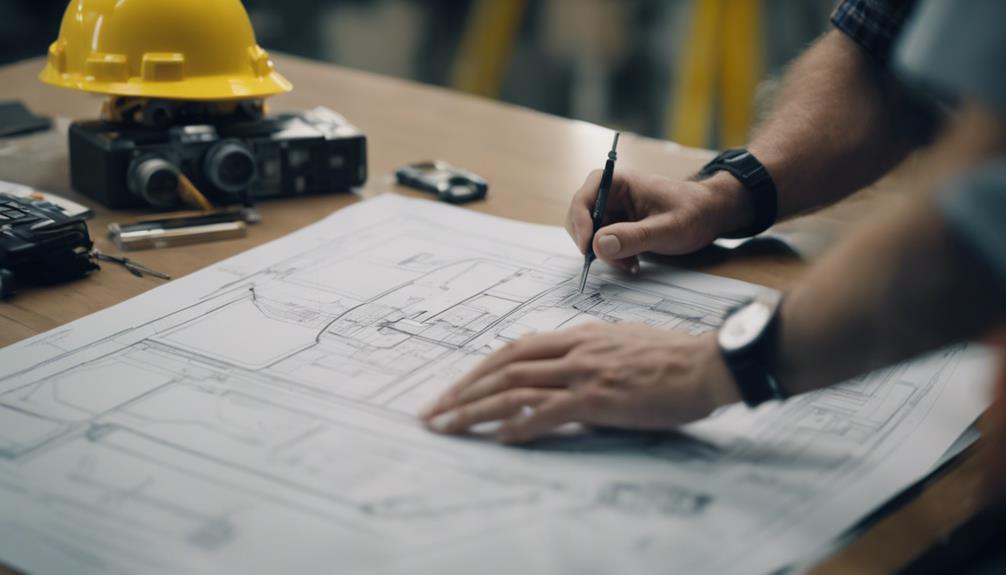To become a crane operator, start by enrolling in accredited training programs such as The Crane School. These programs focus on practical training to develop your skills for crane operation. Certification exams cover crane operations, safety, and regulations. Choosing the right program is crucial for a successful career. Simulation training at The Crane School helps you practice in realistic scenarios to enhance your experience and confidence. Networking with industry professionals can lead to job placements and career growth. Embrace challenges and growth opportunities as you advance in this competitive field. Gain insights on responsibilities and skills to excel in your journey.
Key Takeaways
- Choose accredited training programs like The Crane School.
- Practice with crane simulators for realistic experience.
- Network with industry professionals for job opportunities.
- Stay updated on regulations and safety practices.
- Embrace challenges and continuous learning for career growth.
Certification Process Overview
To become a certified crane operator, you must navigate through an extensive certification process that includes written exams and practical assessments. Crane operators play an important role in the construction industry, guaranteeing the safe and efficient operation of heavy equipment. Certification is necessary to demonstrate your proficiency in handling various types of cranes and prioritizing safety protocols.
Training programs geared towards certification involve thorough preparation for written exams that assess your knowledge of crane operations, safety procedures, and industry regulations. Additionally, practical assessments test your ability to operate the equipment effectively in real-world scenarios. Successfully completing these exams signifies your competence in the field and your dedication to upholding safety standards.
Certifications like NCCCO and CIC are highly respected within the industry, showcasing your expertise in specific types of cranes. This certification process not only enhances your career prospects but also guarantees that you meet the industry's standards for safety, proficiency, and regulatory compliance.
Becoming a certified crane operator opens doors to promising opportunities in a growing and in-demand field.
Choosing Training Programs Wisely

For best outcomes, carefully choose accredited training programs like those offered by The Crane School. When pursuing a career as a crane operator, selecting the right training program is essential.
Accredited programs, such as those provided by The Crane School, guarantee that you receive high-quality education that meets industry standards. These programs focus on hands-on practical training to help you develop the necessary skills to become a skilled crane operator.
Additionally, The Crane School offers tailored guidance and study materials to support you in passing certification exams with confidence. By enrolling in a reputable program like the ones offered at The Crane School, you can rest assured that you're receiving training that aligns with safety regulations and OSHA standards.
Simulation's Role in Training

Simulation training at The Crane School plays an essential role in enhancing crane operators' skills and confidence.
- Hands-On Practice: The crane simulators at The Crane School provide a platform for hands-on practice in realistic scenarios, allowing operators to hone their skills without any real-world risks involved.
- Experience and Confidence: Through simulation training, crane operators gain valuable experience and confidence in handling various crane operations, preparing them for actual job sites.
- Regulations and Safety Practices: Staying updated with regulations and safety practices is vital during simulation training to make sure that operators are well-versed in the necessary guidelines for safe crane operations.
- Advanced Technology: The use of advanced technology in crane simulators enables the creation of realistic crane operations, facilitating effective learning and skill development among aspiring crane operators.
Support From the Crane School

The Crane School provides invaluable support to individuals pursuing crane operator certification through tailored guidance and thorough training. As a student at the Crane School, you'll have access to a range of study materials, practice exams, and simulators that will help you prepare for the certification process effectively.
The expert instructors at the Crane School are dedicated to providing you with extensive training that covers all aspects of crane operation.
Moreover, attending the Crane School will also give you the opportunity to network with industry professionals, allowing you to build connections that can prove beneficial for your career.
Additionally, the Crane School offers career development support, assisting you in job placement and providing guidance for advancement opportunities within the industry.
Advancing Your Crane Operator Career

As you progress in your career as a crane operator, seizing networking opportunities and seeking career development support can pave the way for advancement within the industry. Here are some key steps to advance your crane operator career:
- Networking with Industry Professionals:
Building relationships with professionals in the construction industry can open doors to new job placements and career opportunities.
- Utilizing Career Development Resources:
Take advantage of career development assistance to enhance your skills, explore different paths, and progress in your career as a crane operator.
- Staying Updated with State-of-the-Art Training:
Continuous learning beyond certification is essential. Accessing state-of-the-art training programs with experienced instructors can help you stay competitive in the field.
- Embracing the Career Journey:
Embrace the challenges and growth opportunities along your career journey. The construction industry offers promising prospects for those willing to put in the effort and preparation required for success.
Responsibilities and Skills Overview

As a crane operator, your responsibilities include:
- Inspecting equipment
- Understanding load capacities
- Collaborating with team members for efficient project execution
Essential skills for the role encompass:
- Attention to detail
- Adherence to safety protocols
- Effective communication to guarantee worksite safety
Duties Overview
Regularly examining equipment for safety and functionality is an important responsibility for crane operators. Understanding load capacities is critical for guaranteeing the safe lifting and moving of materials on construction sites.
Interpreting blueprints accurately positions materials, contributing to the success of projects. Collaborating with construction workers and supervisors is essential for seamless operations on the job site.
Attention to detail and adherence to safety protocols are key skills to prevent accidents. Your role as a crane operator involves:
- Examining equipment before operation to ensure safety and functionality.
- Understanding load capacities for the safe lifting and moving of heavy materials.
- Interpreting blueprints to accurately position materials on construction sites.
- Collaborating with construction workers and supervisors to guarantee project success.
Essential Skills
Inspecting equipment, interpreting blueprints, and collaborating with construction teams are important skills for crane operators to ensure safe and efficient operations on job sites.
In the construction industry, crane operators must possess manual dexterity and hand-eye coordination to handle equipment effectively. Understanding load capacities and adhering to industry regulations are essential to guarantee the safety of all workers on site.
Attention to detail and strong communication skills are also crucial for crane operators to coordinate lifts accurately and avoid potential hazards. Operating cranes requires constant awareness of surroundings and the ability to adapt to changing conditions swiftly.
Prioritizing safety by following safety protocols, undergoing regular training, and staying updated on industry standards is vital for crane operators to prevent accidents and maintain a secure work environment.
Frequently Asked Questions
What Is the Highest Paid Crane Operator?
The highest-paid crane operator can earn over $80,000 annually in top-paying industries. Pursue advanced certifications and specialized skills training for better salary prospects. Industry growth and certifications can enhance job prospects and increase earning potential.
How Long Does It Take to Learn to Be a Crane Operator?
To learn to be a crane operator, it typically takes 4-8 months for basic training. Advanced certifications may require 2-5 years. Fast-tracked programs exist for quicker entry. Practical exams are required for certification.
What Is the Highest Paid Crane Operator per Hour?
The highest paid crane operator per hour can earn up to $80 in top-paying industries. Specialized certifications, advanced training, and experience in sectors like oil, gas, or nuclear power can contribute to premium hourly rates.
Is the Crane Certification Worth It?
Yes, crane certification is definitely worth it. With high average salaries, job stability, and opportunities for career advancement in a growing industry, getting certified as a crane operator can lead to a rewarding and lucrative career.
Conclusion
To become a successful crane operator, you must commit to the certification process, choose training programs wisely, utilize simulations, seek support from the crane school, and continuously advance your skills.
Remember, dedication and hard work are the keys to opening a rewarding career in crane operation. So, start your journey now, stay focused, and never stop learning and growing in this exciting field!










